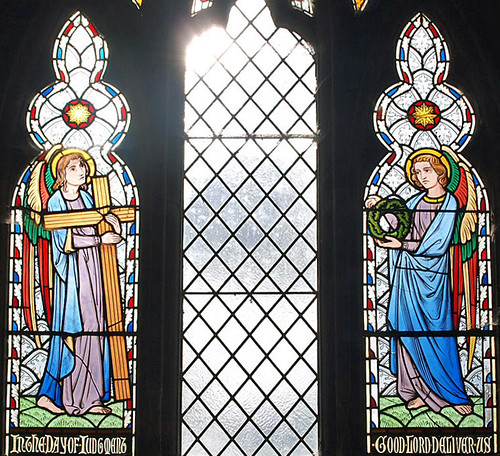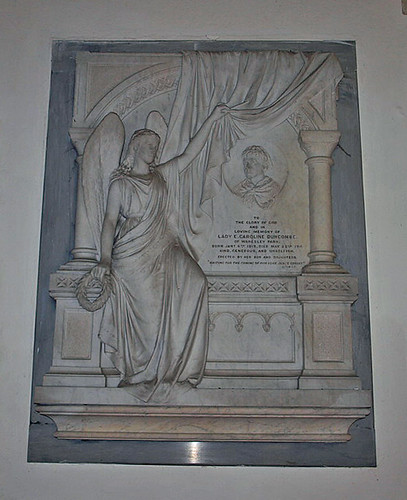ST JAMES. By Butterfield, 1857. Built together with the Duncombe Mausoleum, which connects with the interior of the church by a wall with a window of three stepped lancet lights with foiled circles over. The E wall of the mausoleum has two strange blank arches with blank sexfoiled almond-shapes hanging from their apex. This is the only oddity of the church. Otherwise it is all normal late C13 detail, and the N porch tower (which is unexpected) is slender and noble, with its sheer, steep shingled spire with just a suspicion of broaches. Gothic well-house by the street. Inside, the chancel is one of the most perfect examples of Butterfield’s structural polychromy: stone, red tiles, green tiles, and a little yellow - all in elementary geometrical patterns. - (FONT COVER and BENCHES are excellent and typical. GMCH) - STAINED GLASS. The E and s windows of the chancel, judging by their style, must be by Gibbs, but the N window is a mystery. The background of broad patches of ruby, lilac, and dark mauve is entirely out of the ordinary. Young Bume-Jones is the name that would come to mind, but the style of the figures is not his.
WARESLEY. Here we found still living the two daughters of old William Paine, whose grave is in the churchyard. He was a fine old man born in the first half of the 19th century. He lived through every year of the Victorian Era and through all the Great War, and he lies in a grave under a stately avenue of limes which his own hand planted in the old churchyard of Waresley.
Waresley is a small village on a little hill among the trees, and some of its cottages have thatched roofs, some tall chimney stacks, and some charming Dutch gables. With them stands the inn and the little church, which was not so old as William Paine; he would watch the builders at work on it when he was a boy. It took the place of the old church on the edge of the village which was destroyed in 1724; a cross marks the site of the church in the old churchyard.
But what interests us about William Paine is the little tale of himself that he would tell a hundred times to the village folk as he sat in his old armchair talking of the past. He had a longing to see the Great Exhibition of 1851 which was to usher in the peace of the world, and one morning he got up early and set out to walk to Hyde Park. He left Oliver Cromwell’s county, passed through John Bunyan’s county, walked through the lanes of Charles Lamb’s county, and at last reached the great city and the gate of the Crystal Palace, fifty miles or more from his home. He arrived without a shilling in his pocket, and, not able to pay his way in, he walked round the Great Exhibition and set off home again. He had had his long walk to London, and at the end of it the little walk round the Crystal Palace, and then he trudged home again.
Waresley is a small village on a little hill among the trees, and some of its cottages have thatched roofs, some tall chimney stacks, and some charming Dutch gables. With them stands the inn and the little church, which was not so old as William Paine; he would watch the builders at work on it when he was a boy. It took the place of the old church on the edge of the village which was destroyed in 1724; a cross marks the site of the church in the old churchyard.
But what interests us about William Paine is the little tale of himself that he would tell a hundred times to the village folk as he sat in his old armchair talking of the past. He had a longing to see the Great Exhibition of 1851 which was to usher in the peace of the world, and one morning he got up early and set out to walk to Hyde Park. He left Oliver Cromwell’s county, passed through John Bunyan’s county, walked through the lanes of Charles Lamb’s county, and at last reached the great city and the gate of the Crystal Palace, fifty miles or more from his home. He arrived without a shilling in his pocket, and, not able to pay his way in, he walked round the Great Exhibition and set off home again. He had had his long walk to London, and at the end of it the little walk round the Crystal Palace, and then he trudged home again.


No comments:
Post a Comment